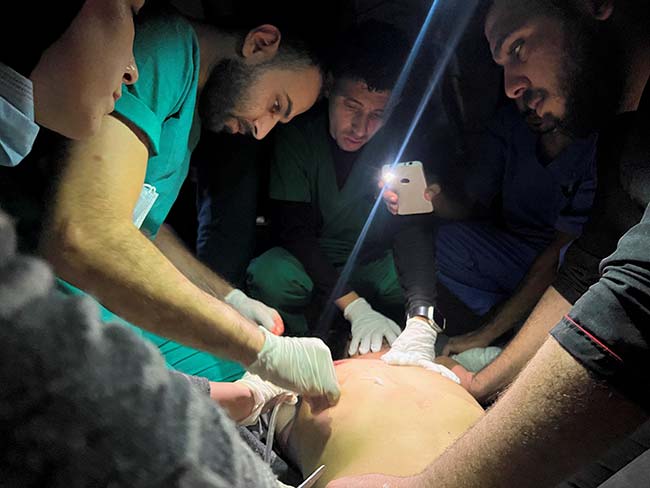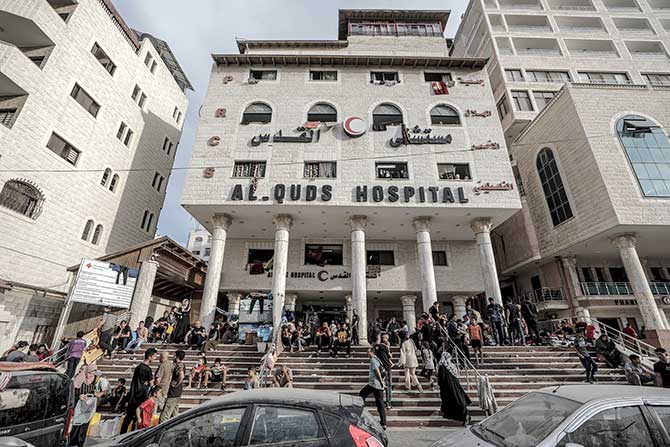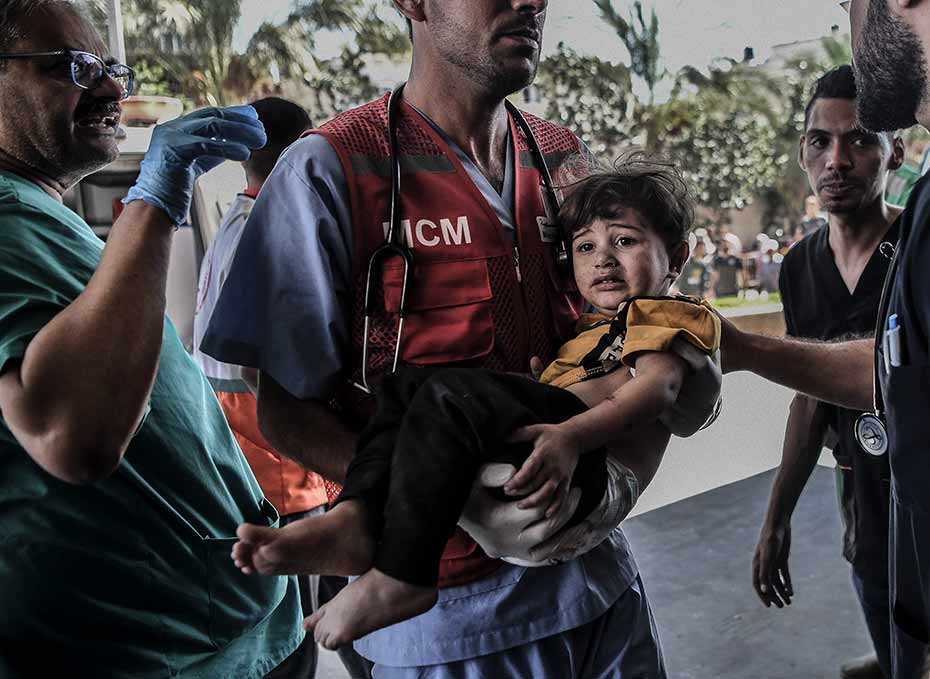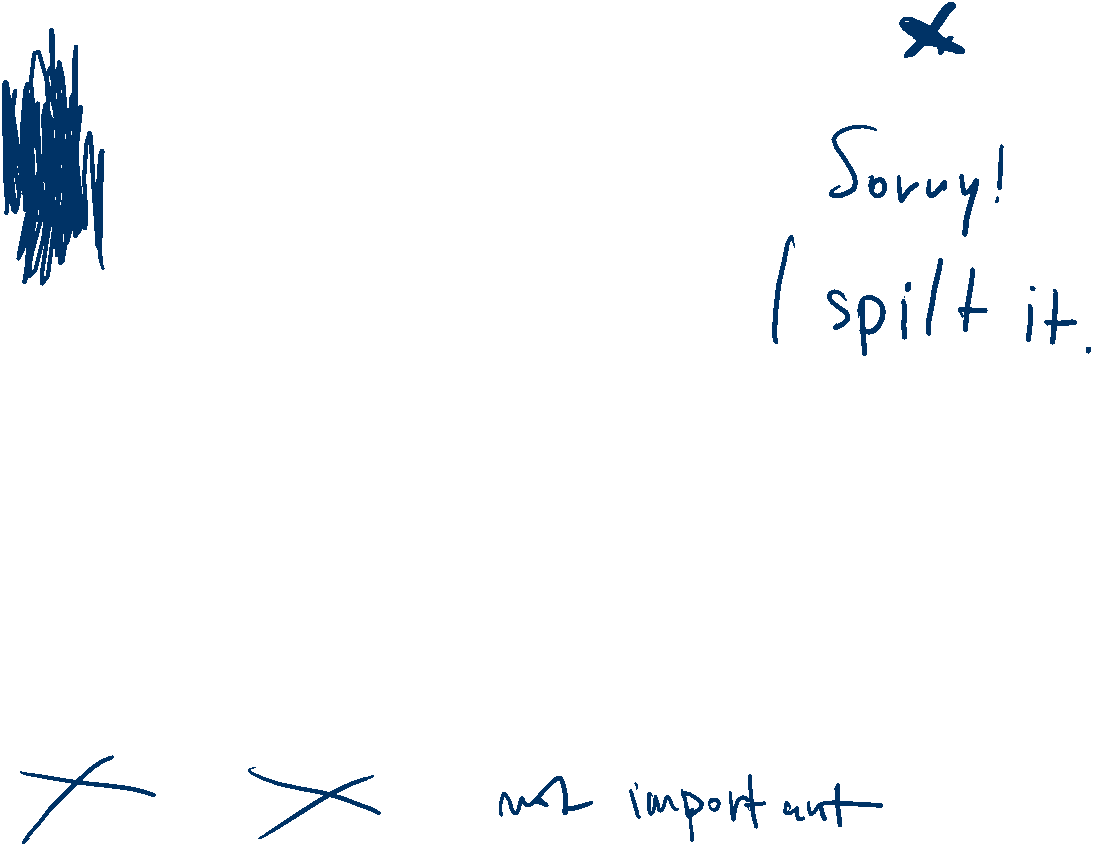This story contains disturbing videos and audio.
Viewer discretion is advised.
CNN Special Report
How Gaza’s hospitals became battlegrounds
Relentless bombardment, power outages and shortages have pushed nearly every hospital in the beleaguered northern Gaza Strip out of service, with evidence of repeated attacks on and in the vicinity of medical facilities despite the presence of doctors, patients and civilians inside, a CNN analysis has found.
At least 20 out of 22 hospitals identified by CNN in northern Gaza were damaged or destroyed in the first two months of Israel's war against Hamas, from October 7 to December 7, according to a review of 45 satellite images and around 400 videos from the ground, as well as interviews with doctors, eyewitnesses and humanitarian organizations. Fourteen were directly hit, based on the evidence collected and verified by CNN and analyzed by experts.
Israel launched its bombardment and ground invasion of the Gaza Strip after Hamas’ October 7 terrorist attack, in which at least 1,200 people were killed and more than 240 others taken hostage. In the first two months of the war, at least 17,100 Palestinians were killed in Israeli attacks on the strip, according to the Hamas-run Gaza Health Ministry. At the time of publishing, that number was more than 23,400.
Israel says that Hamas operates inside and underneath hospitals, and is using them for military operations, including as command centers, weapons stores and to hide hostages. The Israelis have released footage they say is evidence of those Hamas operations. The videos do not offer definitive proof, and Hamas has denied the claims.
CNN sent a list of the hospitals identified as damaged or destroyed to the Israel Defense Forces (IDF). In response, the IDF said it “did not conduct any targeted attacks against hospitals in the Gaza Strip,” adding that “Hamas systematically misuses hospitals and medical facilities.”
Tracking how aerial bombardment has impacted hospitals in northern Gaza gives a sense of the scale and scope of devastation that the war has wrought on the enclave’s health system — and the knock-on impact to civilians who have relied on the facilities for shelter and care, and are more in need of their services now than ever before.




Hospital
Damaged or destroyed
Gaza City
Direct attack
Zikim
GAZA
Med.
Sea
Beit
Lahya
Beit
Hanoun
Rimal
Jabalya
Al-Shifa
Gaza
City
Al-Quds
Wahsh
Be’eri
GAZA
ISRAEL
5 miles
5 km




Hospital
Damaged or destroyed
Gaza City
Direct attack
Zikim
GAZA
Med.
Sea
Beit
Lahya
Beit
Hanoun
Rimal
Jabalya
Al-Shifa
Gaza
City
Al-Quds
Wahsh
Be’eri
GAZA
ISRAEL
5 miles
5 km




5 miles
Hospital
5 km
Damaged or destroyed
Gaza City
Direct attack
Zikim
GAZA
Beit
Lahya
Mediterranean
Sea
Beit
Hanoun
Rimal
Jabalya
Sderot
Al-Shifa
Gaza
City
Al-Quds
Wahsh
Be’eri
GAZA
ISRAEL
Netivot




5 miles
Hospital
5 km
Damaged or destroyed
Gaza City
Direct attack
Zikim
GAZA
Beit
Lahya
Mediterranean
Sea
Beit
Hanoun
Rimal
Jabalya
Sderot
Al-Shifa
Gaza
City
Al-Quds
Wahsh
Be’eri
GAZA
ISRAEL
Netivot




5 miles
Hospital
5 km
Damaged or destroyed
Gaza City
Direct attack
Zikim
GAZA
Beit
Lahya
Mediterranean
Sea
Beit
Hanoun
Rimal
Jabalya
Sderot
Al-Shifa
Gaza
City
Al-Quds
Wahsh
Be’eri
GAZA
ISRAEL
Netivot
CNN identified 22 hospitals in northern Gaza, studying satellite imagery and footage of each site.
Of those, 20 were damaged or destroyed in relentless bombardment during the first two months of the war.
Satellite imagery showed craters near 11 of the hospitals were consistent with those left behind by 2,000-pound bombs. The munitions were dropped near enough for the hospitals to be within the lethal fragmentation radius, which is up to 365 meters (about 1,198 feet).
Fourteen hospitals were directly hit. Several, including Al-Shifa and Al-Quds, appeared to have been attacked by Israel.
Imagery obtained by CNN showed that two hospitals were completely flattened. Attacks on and around the strip’s three pediatric hospitals forced them to cease services. The only hospitals offering dedicated cancer and psychiatric treatment also stopped operating after having been damaged. By the end of the period reviewed, only four hospitals were partially functioning, according to OCHA, the UN humanitarian agency. None had surgery capacity.


The World Health Organization (WHO) said on December 21 that no hospitals were functioning in northern Gaza and injured patients who were unable to be moved were “waiting to die.” According to the WHO, as of January 10, six hospitals in the north were partially functioning.
To provide a window into how Gaza’s hospitals became battlegrounds, CNN took an in-depth look at the deterioration of the strip’s biggest and second biggest medical facilities, Al-Shifa and Al-Quds, up until they ceased operations in November. Al-Shifa has since resumed some services.
Israeli authorities say both hospitals have been used by Hamas for military purposes. The IDF published images of a tunnel shaft and military equipment it said its forces found inside the Al-Shifa complex and video of what appeared to be an armed man outside Al-Quds Hospital. Hamas and hospital officials have denied that the militant group has operated from inside the facilities.
Taken together, the two hospitals reflect the similarities CNN observed in reviewing evidence from the first two months of the war: that what should be protected facilities are being bombed, encircled and shot at by tanks, and that surrounding infrastructure, ambulances and roads are being hit, affecting efforts to treat patients, evacuate facilities and deliver aid.
Several of the hospitals assessed as part of this analysis, including Al-Shifa and Al-Quds, appeared to have been attacked by Israel, according to imagery of munitions fragments, large impact craters, tanks, tank shell holes and tracks from heavily armored vehicles. Experts who reviewed the imagery for CNN said that the aftermath was consistent with damage from high-grade military weaponry used by the IDF.

An earlier CNN investigation determined that a failed Palestinian rocket fired from Gaza was likely the cause of a deadly blast at the Al-Ahli al-Arabi Hospital, also known as the Baptist Hospital, on October 17.
In other cases, it was not possible to determine responsibility for the attacks.
The IDF has repeatedly said it does not target hospitals but has admitted to returning fire at some facilities, including Al-Quds. In response to CNN’s analysis, the IDF said that strikes against targets near hospitals “undergo a thorough planning process,” to ensure the munitions chosen mitigate damage to civilians and civilian infrastructure, and that any strike expected to incidentally damage hospitals “is approved by the highest echelons of command.”
“Our forces on the ground know where these hospitals are, and nodes are taken into account when they're operating,” a legal adviser to the IDF told CNN about the process. “But at the end of the day, as long as Hamas continues to use these hospitals and facilities for the military operations, and our aim is to defeat Hamas militarily, there is absolutely no choice but to go there.”

Hospitals and other medical establishments are protected civilian objects under international humanitarian law. It is illegal, with few exceptions, to attack hospitals, ambulances or other health facilities, or to otherwise prevent them from providing care. A hospital can lose its special protected status only if it is used by an armed group for acts that are “harmful to the enemy.” But, even if a hospital loses its special status, the wounded and sick inside are still protected by the principle of proportionality. A warning must be given, and time for safe evacuation, before carrying out an attack.
“In many cases it's impossible to evacuate everyone from a hospital, so there are still medical personnel and patients inside,” Cordula Droege, the chief legal officer of the International Committee of the Red Cross (ICRC), told CNN. “The onus is on the attacker... to take all precautions to avoid that they come to harm.”
Al-Quds Hospital
Israel has repeatedly called for the evacuation of 22 hospitals in northern Gaza. But doctors operating in the hospitals, as well as international organizations, have said the evacuation of injured patients and staff is incredibly dangerous, if not impossible, amid the fighting.
Israel first ordered Al-Quds Hospital in Gaza City, which is run by the Palestine Red Crescent Society (PRCS), to be evacuated on October 14, according to the humanitarian organization. The group, which is affiliated with the ICRC, said that it couldn’t evacuate the hospital’s 500 patients – particularly those in the ICU and babies in incubators – nor could it move 12,000 displaced people, many of them women and children, who had sought refuge there.
CNN used a 3D model to reconstruct the attacks on and in the vicinity of Al-Quds Hospital, drawing on verified videos and images from social media, as well as aerial footage shared by the IDF.
On October 18, Al-Quds was rattled by airstrikes about 100 meters (328 feet) away. Videos filmed from the hospital showed an explosion lighting up the night sky and a building nearby being struck, as people huddled inside the hospital’s front entrance.
More strikes were reported near the hospital on October 22. On the same day, Saleem Aburas, a PRCS relief coordinator, shared footage from outside of Al-Quds showing fragments that he said were from “occupation army missiles.” Marc Garlasco, a military adviser at the Dutch organization PAX for Peace and a former UN war crimes investigator, said that it looked like remnants from a military-grade aerial munition, not a Hamas rocket.

Patrick Senft, a research coordinator at Armament Research Services (ARES), said the fragments were most likely from “high explosive projectiles fired from tanks or artillery guns,” which could have been fired from “something like a main battle tank, but also something like a self-propelled howitzer.”
A week later, on October 29, another strike hit several meters away from Al-Quds. Footage from inside showed windows blown out, broken glass and rubble, and people rushing from smoke-filled rooms coughing and covering their mouths. Outside, a cloud of smoke billowed from the site.
The PRCS said that Israel had warned it to evacuate ahead of the bombardment and alleged it was deliberately striking “next to Al-Quds" to force people out. The IDF told CNN that it had issued multiple evacuation warnings. Al-Quds’ director, Dr. Bashar Mourad, said there were no safe routes to flee and that ambulances attempting to move south were targeted with artillery fire. “The bombings are occurring all around us,” Mourad told CNN.
As Israel’s ground forces closed in on Gaza City, explosions around Al-Quds became an almost daily occurrence. On November 2, the PRCS said Israeli military vehicles about 1 kilometer (0.6 miles) south of the hospital fired bullets “indiscriminately,” injuring two people standing outside and penetrating the hospital’s sixth floor, sharing a photo of what Garlasco said appeared to be an unexploded mortar embedded in an interior wall.

A day later, the PRCS said that at least 21 people were injured at Al-Quds when internal glass walls shattered, and part of the ceiling fell due to Israeli strikes. Blasts were reported nearby on November 4 and 5, with videos showing the aftermath, including a building that was destroyed a couple of blocks away and broken glass inside the ICU.
The IDF released aerial footage on November 7 showing a strike on a building, which they claimed was a Hamas weapons depot, and that CNN geolocated to just over 100 meters (328 feet) from Al-Quds Hospital. It appeared to be the same block targeted on November 5.
CNN reviewed satellite imagery of Al-Quds and the surrounding area throughout October and November. On November 7, when people were still sheltering there, the hospital was surrounded by damaged buildings and large craters.
Garlasco said that one large crater to the west of the hospital looked like the result of a precision-guided munition, and was consistent with the aftermath of either a 1,000-pound Joint Direct Attack Munition (JDAM) or precision artillery used by the IDF.
On November 10, the PRCS said that one person was killed, and 28 others injured, most of them children, when Israeli forces opened fire at the hospital’s ICU. The group said that continuous shelling had destroyed nearby streets, blocking aid in and evacuations out of the hospital. Amid power outages caused by dwindling fuel, videos showed doctors operating by flashlight.
The IDF released footage on November 13 that it said showed a group of armed men at the entrance of Al-Quds Hospital, at least one of whom appeared to be carrying a rocket-propelled grenade launcher. Israel said in a statement that its forces killed “approximately 21 terrorists” when they returned fire after the militants shot at their tank from the hospital, adding that civilians were seen leaving the hospital during the exchange.
The PRCS condemned Israel’s “false claims” and said no armed individuals were operating in Al-Quds. A video shared by Aburas, the PRCS relief coordinator, showed an Israeli tank firing on Al-Quds from the same location pictured in the IDF footage. The person filming ducked away from the window and a woman could be heard crying in the background.
Al-Quds Hospital ceased operations on November 13. Soon after, footage showed hundreds of people fleeing to the south on foot, with some being carried on stretchers.
When asked about how Israel assesses proportionality when considering whether to attack hospitals, the IDF legal adviser told CNN: “In our situation, that [proportionality] is almost irrelevant, because, on the whole, we haven't conducted attacks against hospitals.”
“There have been a very small number of occasions where because there’s been an immediate threat to the life of our soldiers we’ve had to fire at hospitals,” the legal adviser added, referring to Al-Quds.
Craig Jones, a lecturer at Newcastle University in the United Kingdom, rejected the notion that proportionality might not be relevant, saying that the rule applies whenever a military objective is the object of an attack. For his book, “The War Lawyers,” Jones examined the laws of war applied by military lawyers to targeting operations carried out by the IDF in Gaza.
"They are careful, deliberate calculations that take place behind the scenes. And I think it's a point worth emphasizing that much of the death and destruction that we see, including damage to the hospitals, is known in advance,” Jones told CNN, adding that the damage is a calculated choice, not an inevitability.

Al-Shifa Hospital

About 2.6 kilometers (1.6 miles) north of Al-Quds, Gaza’s largest hospital, Al-Shifa, has emerged as another flashpoint. Israel has said that a Hamas command center sits underneath the medical complex and that the group has used it to hold hostages, repeatedly calling for the hospital to be evacuated. Hamas has denied the claims, as have health officials working there.
In the first weeks of the war, patient numbers at Al-Shifa surged. Ghassan Abu-Sittah, a British-Palestinian surgeon who was working at the hospital, told CNN on November 3 that it was operating off only one generator. “Unless there's electricity, this hospital will turn into a mass grave,” he said. “It's as simple as that: If we cannot keep the ventilators running, if we can't take our critically wounded patients back to the operating room, then there's nothing for this place other than to come and die.”
On the same day, an Israeli airstrike hit a convoy of ambulances, which hospital authorities said were being used to evacuate the wounded, including one outside the entrance of Al-Shifa, killing 15 people and wounding 60 others. Videos from the scene, verified by CNN, showed about a dozen people lying bloodied and motionless. Garlasco, who analyzed the footage, said that cubic fragmentation could be seen on the ambulance door, as well as the clothes of people killed and wounded, which was consistent with aftermath from an Israeli Spike anti-tank guided missile.
The IDF said it had targeted the ambulance because it was “being used by a Hamas terrorist cell,” accusing the group of transferring militants and weapons in ambulances but did not offer evidence. Hamas rejected the allegations as “baseless.”

100 feet
30 meters
Intensive
Care Unit
Ambulance
attack
Nov. 3
.
.
Courtyard
Nov. 10
.
Al-Shifa
Hospital
Outpatient
clinic
Nov. 10
.
Maternity Unit
Nov. 10
.
NORTH

100 feet
30 meters
Intensive
Care Unit
Ambulance
attack
Nov. 3
.
.
Courtyard
Nov. 10
.
Al-Shifa
Hospital
Outpatient
clinic
Nov. 10
.
Maternity Unit
Nov. 10
.
NORTH

100 feet
30 meters
Intensive
Care Unit
.
Ambulance attack
Nov. 3
.
Courtyard
Nov. 10
.
Al-Shifa
Hospital
Outpatient clinic
Nov. 10
.
Maternity Unit
Nov. 10
.
NORTH

100 feet
30 meters
Intensive
Care Unit
.
.
Ambulance attack
Nov. 3
Courtyard
Nov. 10
.
Al-Shifa
Hospital
Outpatient clinic
Nov. 10
.
Maternity Unit
Nov. 10
.
NORTH
As attacks and fighting raged, thousands of displaced Gazans sought safety at Al-Shifa. Satellite imagery from November 7 showed blue and white tarpaulins in the hospital’s courtyard and parking lot where people had set up makeshift shelters. Videos captured crowds of people crammed inside, sleeping in hallways and stairwells.
On November 10, just after 1 a.m. a projectile flashed across the sky and crashed into the courtyard. Footage of the aftermath showed a man, his leg maimed, crying out in pain and blood spattered across the concrete.
It was the first of several strikes that morning on different parts of the complex, including the hospital’s maternity department and outpatient clinic. Dr. Munir Al-Bursh, director-general of the Hamas-run Gaza Health Ministry, told CNN that there were 15 casualties in the strikes, and that bodies were piling up but could not be buried. Some 400 patients and 20,000 displaced people were still inside the medical facility, he said.
The Israeli military claimed a projectile launched by Palestinian militants and aimed at IDF troops operating in the area had hit the hospital. But at least two of the projectiles that struck the site appeared to have been Israeli munitions, according to footage verified by CNN and reviewed by experts.
In one of the first videos filmed in the aftermath of the courtyard strike, people could be seen probing a munition remnant that, according to Garlasco, appeared to be an Israeli illumination artillery round.
The round is fired, then releases an illuminating canister with a parachute attached, which illuminates target areas at night.
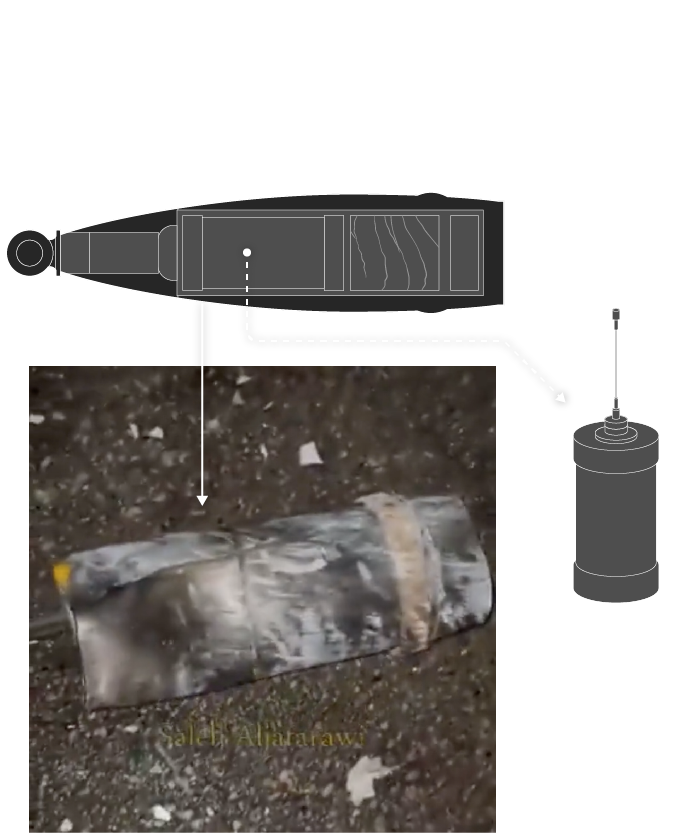
Another video captured a metal fin amid rubble and debris in the maternity department, which was hit a few hours later. Senft told CNN the remnants and structural damage were “consistent with the tail assembly of several Israeli tank gun projectiles,” but added that without remnants of the warhead it was not possible to determine the type of tank projectile. Garlasco said the tail fins appeared to be from Israeli 120-millimeter high explosive tank shells.
Designed to defeat medium and light armored vehicles and infantry, it has an effective range of over 4 kilometers (2.5 miles).
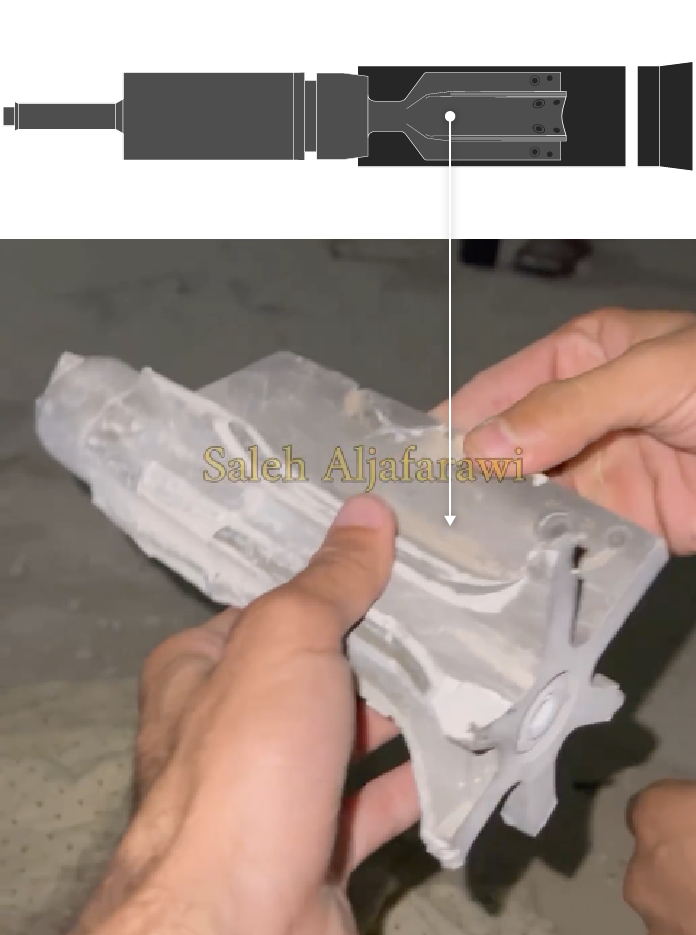
Another strike hit the maternity department after 8 a.m., blowing out a large section of the upper floor of the building, which was seen in footage of the aftermath and satellite imagery.
“The destruction of the outer wall combined with the fragmentation and tail entry hole are all indicative of a 120-millimeter tank round,” Garlasco said. “These shells have a 4,000-meter range and often over-penetrate in urban areas, meaning it is possible the IDF was engaged with Hamas some distance from the hospital and either missed their targets, or the rounds continued until they hit the hospital.”
Around 10 a.m., a projectile hit the outpatient clinic, near the maternity unit. Footage showed a gaping hole in the corrugated metal roof covering an area where displaced people were sheltering, and a man lying motionless on the ground. Garlasco and Senft, the weapons experts, said they could not be definitive about what caused the strike based on the blast hole alone.
Dr. Ashraf al-Qidra, spokesman for the Gaza Health Ministry, who was in Al-Shifa at the time, said on November 11 that the hospital’s ICU and pediatric department had also been hit, and that doctors were having to move patients within the complex as strikes continued.
Footage and photos showed dozens of premature babies being rushed from the neonatal unit’s incubators after the oxygen supply ran out, wrapped in foil to keep warm.

Khader Al Za’anoun, a freelance journalist for the Palestinian news agency WAFA, who was embedded at the hospital, sent CNN scores of videos and photos showing the deterioration of the complex. One of the clips captured the aftermath of strikes on the ICU, which was covered in dust and rubble. Holes were visible in the walls that were consistent with the shape left behind by Israeli tank missiles, Garlasco told CNN.
Over the next few days, amid pouring rain, Al Za’anoun recorded people at the hospital digging graves in the courtyard, bringing bodies down for burial. In a series of videos, a 10-year-old girl, Sumaiyah Al-Hossary, could be seen following her mother’s body as she was carried outside on a gurney, wrapped in a blue blanket with white flowers and marked with her name in masking tape. Cellphone in hand, Al-Hossary filmed her mother's burial before placing a leaf atop her grave.
The same mass grave was observed by a WHO team that led a mission to Al-Shifa a week later. They said they were told more than 80 people were buried there and described the hospital as a “death zone.”
Israeli Prime Minister Benjamin Netanyahu said in an interview with CNN on November 12 that there was "no reason" patients could not be evacuated from Al-Shifa after the IDF opened an evacuation corridor on the eastern side of the hospital. But doctors said they had refused the IDF’s evacuation orders for fear of what would happen to their 700 at-risk patients.
On November 15, Israeli tanks surrounded Al-Shifa. Satellite imagery showed large sections to the north and south of the hospital had been bulldozed ahead of the raid. A doctor told CNN the IDF gave them a 30-minute warning before they swarmed the complex. The Palestinian journalist, Al Za’anoun, said Israeli forces had “invaded the hospital with large numbers of soldiers and military vehicles, including tanks, armored vehicles, troop carriers, and bulldozers,” adding they were preventing anyone from leaving.
The IDF did not respond to CNN’s request for comment on the report, but did say that its operation at Al-Shifa involved troops entering from the ground “in order to minimize” interference with medical care, and limit harm to patients or medical personnel.
A senior US intelligence official told CNN that the US had independently corroborated information suggesting that Hamas and other Gaza militants were using Al-Shifa Hospital as a command hub, but added that Hamas members had largely evacuated days before the IDF raid.
Days later, Israeli soldiers were still inside the complex conducting searches and interrogations, and officers said they had found rifles, ammunition and other military equipment inside. “They are within the hospital now, they are troops, in front of me while I am talking. We can see them checking and searching this part of the hospital,” a senior plastic surgeon at Al-Shifa, Dr. Ahmed El Mokhallalati, said, adding that staff were being questioned about Hamas.
The hospital’s director, Dr. Mohammed Abu Salmiya, was detained and later arrested along with several other medical staff.

On November 19, the IDF released footage showing a tunnel shaft and an entrance to what it called an “underground facility,” which it said it would demolish. The IDF also took CNN and other news organizations to show them the shaft on the grounds of Al-Shifa. But the evidence did not establish without a doubt that there was a command center underneath the hospital.
After weeks living under siege, civilians who had been trapped inside Al-Shifa finally started to leave, fleeing to the south of Gaza, footage showed. The PRCS said 31 premature babies were successfully evacuated from the hospital to Egypt for medical treatment.
Volker Türk, UN high commissioner for human rights, said that the events at Al-Shifa beggared belief and that while hundreds of people had fled the hospital, “Nowhere is safe in Gaza.”
“Rules of international humanitarian law, including the principles of distinction, proportionality and precautions in carrying out the attacks must be strictly adhered to,” Türk said. “Failure to adhere to these rules may constitute war crimes.”
How CNN reported this story
For this investigation, CNN determined that 20 of 22 hospitals in northern Gaza were damaged or destroyed in the first two months of Israel’s war against Hamas, from October 7 to December 7, by drawing on several data points. CNN analyzed 45 satellite images provided by Maxar Technologies and Planet Labs, and around 400 videos verified from social media and shared directly by Khader Al Za’anoun, a freelance journalist on the ground.
The satellite imagery showed craters near 11 of the hospitals were over 12 meters (39.3 feet) in diameter, which is consistent with those left behind by 2,000-pound bombs. The munitions were dropped near enough for the hospitals to be within the lethal fragmentation radius, which is up to 365 meters (about 1,198 feet). Two of the hospitals were completely flattened.
CNN shared the satellite imagery and footage with weapons experts who assessed it for evidence of direct or indirect attacks, based on munitions fragments, large impact craters, tanks, tank shell holes and tracks from heavily armored vehicles. Fourteen hospitals were directly hit. Several, including Al-Shifa and Al-Quds, appeared to have been attacked by Israel. This analysis was supported by interviews with doctors, eyewitnesses and humanitarian organizations.
